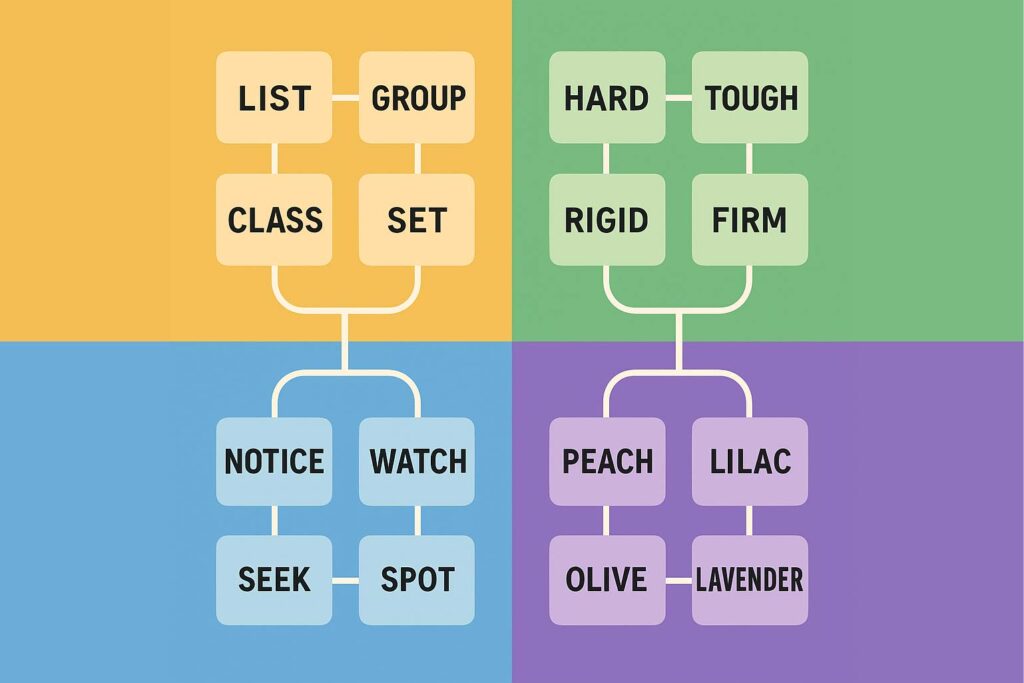The New York Times Connections puzzle has become a daily ritual for many word-game lovers. Unlike crossword puzzles or Wordle, this game challenges players to find relationships between 16 seemingly unrelated words, grouping them into four categories. Sounds easy? Not quite. Some word groups—especially the infamous purple category—can leave even seasoned players scratching their heads.
If you’re searching for the NYT Connections hint today, you’re probably trying to crack those tricky categories without ruining the fun. In this guide, we’ll explore how to identify the hardest word groups, spot subtle connections, and level up your solving skills.
Understanding How NYT Connections Works
Before diving into strategies, here’s a quick refresher:
- 16 words appear on the grid.
- They need to be sorted into 4 groups of 4 based on a shared theme.
- Categories can range from pop culture to science, slang to geography.
- Color-coded difficulty:
- Yellow = easiest
- Green = medium
- Blue = hard
- Purple = trickiest
The purple category often requires lateral thinking, niche knowledge, or spotting wordplay.
Why the Hardest Groups Are So Tricky
The hardest NYT Connections word groups tend to have one (or more) of these traits:
- Ambiguous meanings—words that fit multiple categories.
- Niche references—specific to pop culture, sports, or history.
- Subtle wordplay—homophones, puns, or idioms.
- Hidden patterns—numbers, colors, or rhyming words disguised among unrelated terms.
For example, “Mercury” might fit Planets, Roman gods, or even Chemical elements depending on the puzzle’s design.
Spotting the Hardest Word Groups—Step-by-Step
Eliminate the Obvious First
Start by solving the yellow and green categories. This clears the grid and makes it easier to focus on the tricky ones.
Look for Double Meanings
Some words act as “connectors” between two categories. Write them down separately and consider their alternative definitions.
Example:
- “Pitch” could relate to sports, music, or marketing.
Group by Hidden Themes
When words don’t seem related on the surface, think:
- Do they rhyme?
- Are they brand names?
- Do they belong to the same decade?
Beware of the “Trap Category”
NYT often places decoy sets that almost work but are slightly off—forcing you into mistakes.
NYT Connections Hint Today (General Strategy)
While we can’t spoil today’s exact answers, here’s a non-spoiler approach you can apply daily:
- Start broad—identify the most obvious category.
- Check for theme overlap—avoid rushing; some words might have hidden meanings.
- Think culturally—NYT loves references from TV shows, movies, sports, and history.
- Don’t ignore your instincts—sometimes the first guess is the right one.
Pro Tips from Frequent Players
- Keep a notebook of tricky patterns you’ve seen before.
- Play with friends—different minds catch different clues.
- Read yesterday’s answers—this builds category recognition.
- Use a timer—improves speed and sharpens focus.
- category page.
Conclusion: Challenge Accepted
The NYT Connections hint today isn’t just about giving away an answer—it’s about sharpening your puzzle-solving skills so you can spot the hardest word groups on your own. By learning to recognize patterns, double meanings, and hidden themes, you’ll turn frustration into that satisfying “aha!” moment.
Your turn: Fire up today’s puzzle, try these strategies, and see how far you can go before peeking at a hint. And remember—every tricky purple group you conquer makes you a better player for tomorrow.
FAQs
1. What is NYT Connections?
NYT Connections is a daily puzzle game by The New York Times where players group 16 words into four related categories. Each category has a different difficulty level, from easiest (yellow) to hardest (purple).
2. What does “NYT Connections hint today” mean?
It refers to non-spoiler clues or tips for the current day’s puzzle. These hints help players without directly giving away the answers.
3. Why is the purple category so hard?
The purple group often involves subtle wordplay, niche knowledge, or unexpected connections that require lateral thinking rather than obvious pattern matching.
4. How can I improve my NYT Connections skills?
- Start by solving the easiest categories first.
- Watch out for double meanings in words.
- Review past puzzles to recognize recurring patterns.
- Play regularly to build your speed and accuracy.
5. Can I find past NYT Connections puzzles?
Yes, The New York Times keeps an archive of past puzzles for subscribers. You can review them to practice and understand the types of categories they use.
6. Is it okay to use hints every day?
Yes! Using hints can help you learn and get better over time. The key is to use them as learning tools rather than shortcuts.
7. Where can I play NYT Connections?
You can play directly on The New York Times Games website or through the NYT Games app on mobile devices.
Read more articles here: Scribbr AI Detector.




